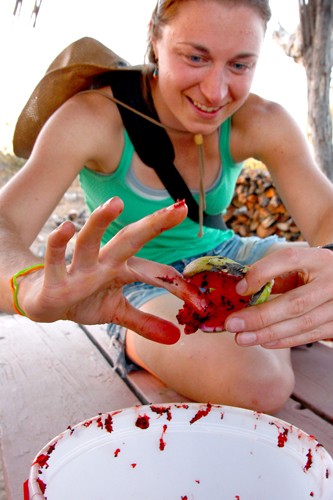At a small camp nestled at the end of a dirt road in the heart of Saguaro National Park, Stella Tucker keeps a time-honored tradition of the Tohono O’odham tribe alive.
Every summer, Tucker and her family return to their small camp to gather fruit from the saguaro cactus until the monsoon rains come. Tucker uses saguaro fruit to make syrup, jam and a wine that is used in a Tohono O’odham wine ceremony.
View a photo gallery of the saguaro fruit picking here.
“”I remember when my great grandfather would get his wagon and his horses ready and we would go out to our camp in the mountains,”” she said. “”We would carry our bedding and our water and our food, and we camped there until we made enough syrup to bring home.””
While the wine ceremony and the harvesting of saguaro fruit remain Tohono O’odham traditions, Tucker said younger generations of her tribe are losing interest in the practice.
“”When I first started coming here with my grandmother, there were five or six families living here, doing the harvest,”” Tucker said. “”Now I am the only one here. The younger people aren’t coming out to take over the harvest and keep the tradition alive.””
While, according to Tucker, the saguaro fruit harvest has lost popularity among younger generations of Tohono O’odham, the Undergraduate Biology Research Program at the UA has been helping Tucker and her family with the harvest for 22 years.
A week ago, Carol Bender, director of UBRP, led a group of undergraduate and graduate biology students on a trip to Saguaro National Park West to help Tucker with the harvest.
“”We have been doing this for so many years, it has almost become a tradition for UBRP,”” Bender said.
After arriving at Tucker’s small camp late in the afternoon, students and volunteers separated into groups to hunt down and harvest the fruit.
Each group was given a long pole made from the spine of a dead saguaro with which to knock the cactus fruit down.
One student would knock the fruit down and another would attempt to catch it in a plastic bucket — a process that sounds easier than it actually is.
“”It seems like only the tall ones have fruit,”” said Michelle Lacomb, an undergraduate from Rice University who was participating on the trip.
While many of the cacti were overburdened with fruit, a good portion of it was not ready for harvest, a trend that Tucker said has been increasing over the years.
“”This year the fruit is really late,”” Tucker said. “”There was a time when we used to pick through the whole month of May. Now it seems to be moving into the month of June.””
Bender said during the same time last year, she remembered more fruit ready to be harvested.
“”Last year, there was so much fruit and it was so ripe that by the end of the night, we all looked like the victims of an ax murderer,”” she said.
UA students and volunteers spent almost three hours examining saguaros and hunting for a hint of red, a telltale sign that signifies the fruit is ripe.
“”It tastes like the fruit of my labor mixed with the dirt of the pole,”” said biochemistry senior Scott Ogley. “”It’s actually really good.””
“”You definitely want to catch it with the bucket and not your hand,”” said Vincent Denef, a post-doctoral researcher in UC Berkeley’s Department of Earth and Planetary Science.
When the sun finally crested over the mountains, UBRP members returned to Tucker’s small camp to scoop bright red saguaro fruit into buckets.
“”When the saguaro flower dies, it becomes kind of like a knife that you can use to scoop out the fruit with,”” Bender said.
For nearly an hour, students and volunteers scooped the sticky red fruit into buckets. By the time they finished, Tucker provided the UBRP members with a dinner of flour tortillas, beans and cholla buds, another delicacy of the Sonora Desert.
As the night drew to an end, Tucker sat down with UA students to discuss Tohono O’odham traditions, the saguaro fruit harvest and the process by which she makes the fruit into jam and syrup.
“”I might get three jars of syrup from your pick and the fruit I’ve harvested over the last two days,”” she said.
In the end, Tucker said participating in the saguaro fruit harvest is just something that she loves to do.
“”It is just something in your heart that you enjoy doing,”” she said. “”I guess that’s me. It is so much a part of my life, I look forward to this every year. I will continue to do it until I am not able to do it.””









